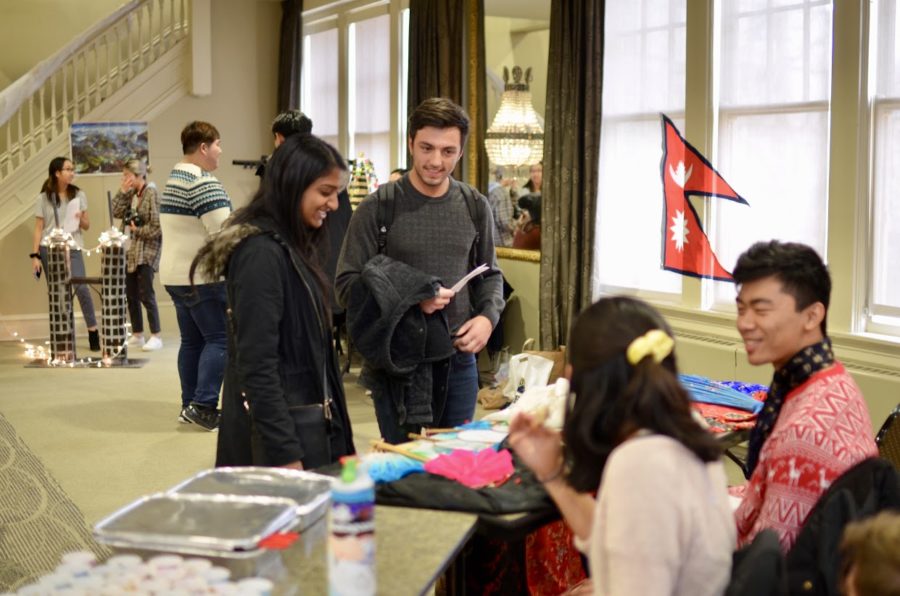Several students engaged in matches of Rock, Paper, Scissors on Saturday to see who would ascend Mount Everest first.
This did not take place in the Himalayas, but rather as a game held in the O’Hara Student Center as part of the XSA Asian Culture Fair Saturday. Groups of students roamed around exhibits representing different Asian cities while learning about cultural dances, music and food.
More than 130 students attended the fair hosted by the Asian Students Alliance and the Korean, Vietnamese, Chinese-American and Filipino student associations for the first time in two years. Each group created an exhibit representing a city central to their cultures — Ho Chi Minh City for VSA, Seoul for KSA, Beijing for CASA and and Manila for FSA. ASA also put together an area for lesser-known regions of Asia.
Each city included several activities to give students a better understanding of the culture of that particular region, including trying Vietnamese coffee, learning the basics of a Filipino dance called tinikling, having their fortune told and playing a game where participants raced each other to climb a makeshift Mount Everest.
Emily Hua, a sophomore majoring in computer science and member of ASA, bounced between exhibits prior to the event, making sure everything was ready for students to take part in what has been coined the “Tour of Asia” at this year’s Asian culture fair. She said the group came up with the theme earlier this year, spent several months working on their own projects and then reconvened to exhibit their finished products together.
“We thought, ‘What if we could bring like a really big city from Asia here and exhibit it to give students a chance to see what it would be like to be in that city and the culture it would have outside of just the touristy aspects?’” Hua said.
Courtney Yu, a junior studying economics and computer science and president of ASA, said the “Tour of Asia” was not executed last year since the groups wanted to focus more on their own separate projects. Yu said Pitt “isn’t the most diverse school,” with about 72 percent of undergraduates at Pitt’s main campus identifying as white, according to the 2018 Pitt Fact Book. She said that makes it more important for minority groups to collaborate and “bridge the gap.”
“Given the current political climate, it seems really easy to pit people against each other, so we just want to support each other with more events like this,” Yu said. “It has really pushed us to reach out to other students.”
Standing by the student-made statue of Filipino National hero Jose Rizal — who inspired the Philippine Revolution against the Spanish in 1896 — directly across from a model of the Great Wall of China, Nina Ordinario, president of FSA and a junior health information management major, said she was proud of the sets of the different organizations, admiring different installations such as VSA’s miniature replica of Ho Chi Minh City Hall.
“I think they turned out really well,” Ordinario said. “A lot of us don’t really communicate because we are so busy running our own clubs, so it’s really nice to come together and show off what we’ve been working on for the past few months. Like VSA’s clock tower is so cool, and we built a statue to Rizal.”
John Juozitis, a sophomore studying at Pitt’s business school, said he participated in almost every activity at each of the city exhibits. While admiring traditional Vietnamese clothing, he said he would like to see more events like this made available to students to give people a better perspective of different cultures.
“I don’t know a lot about different Asian cultures so I thought it would be cool to come here and try out the games and the food,” Juozitis said. “I’d say my favorite part is the food. But I also enjoyed watching the tinikling, and everyone is really nice and open to talk about their clubs and their own experience with their culture.”
All the different organizations used to focus more on their own activities, Mimi Nguyen, a junior studying psychology and co-president of VSA, said. But the organizations decided to come together a few times a year to put on events such as the culture fair to give students with little knowledge about Asian cultures the opportunity to learn more.
“At first they started out as very different ethnic groups, but because we are from the same regional area, so like most of Asia, we share a lot of things in common, and so whenever there are really big events that involve politics or food, everyone relates to that. We come together as all five groups,” Nguyen said.
While trying his hand at fish crab prawn — a common Vietnamese gambling game — junior biology major and president of KSA Russell Yoo said the fair was beneficial for the organizations because it helped defeat common yet incorrect stereotypes about the uniformity of Asian cultures.
“When people think of Asia, they usually think of it as one big region,” Yoo said. “Really Asia has many different parts.”
Editor’s note: A previous version of this article listed the the Asian Students Alliance and the Korean-, Vietnamese-, Chinese-American and Filipino student alliances as the hosts of the event. It also said 30 people attended the event. This information is false. The Asian Students Alliance and the Korean, Vietnamese, Chinese-American and Filipino student associations hosted the event, and more than 130 students attended. The current article reflects these changes. The Pitt News regrets these errors.


